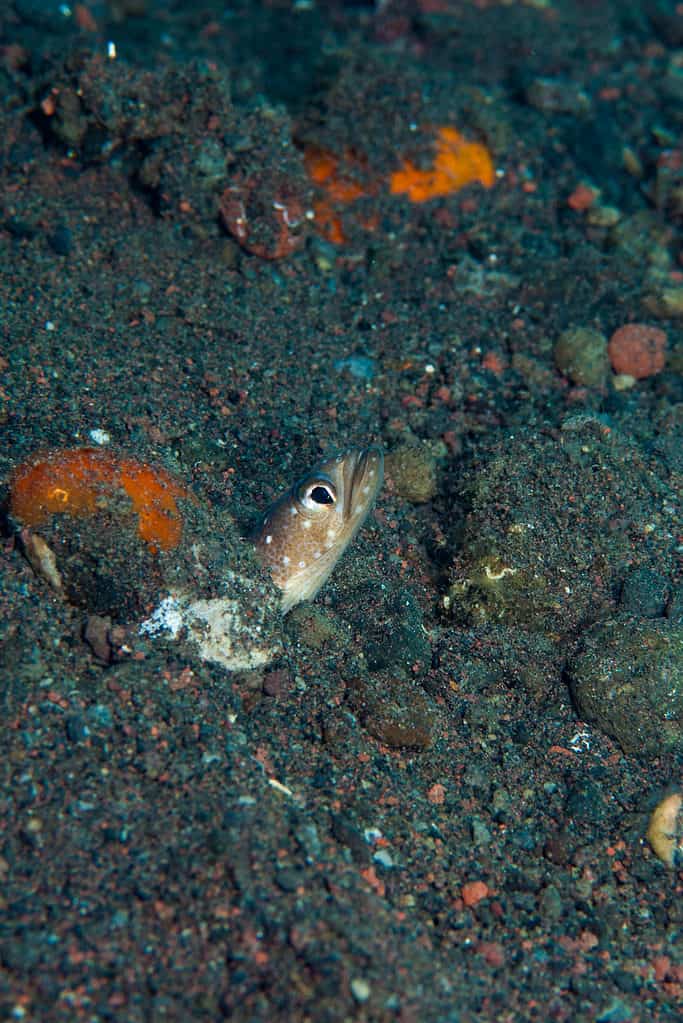Pacific Spaghetti Eel
Gorgasia japonica
They have excellent eyesight
Advertisement
Pacific Spaghetti Eel Scientific Classification
- Kingdom
- Animalia
- Phylum
- Chordata
- Class
- Actinopterygii
- Order
- Anguilliformes
- Family
- Congridae
- Genus
- Gorgasia
- Scientific Name
- Gorgasia japonica
Read our Complete Guide to Classification of Animals.
Pacific Spaghetti Eel Conservation Status
Pacific Spaghetti Eel Facts
- Prey
- Zooplankton
- Name Of Young
- Juveniles
- Group Behavior
- Colony
- Fun Fact
- They have excellent eyesight
- Most Distinctive Feature
- Large eyes
- Distinctive Feature
- Long, slender body
- Habitat
- Temperate waters near reefs
- Predators
- Triggerfish and snake eels
- Diet
- Herbivore
- Type
- eel
- Common Name
- Pacific spaghetti eel
- Special Features
- Cement-like secretion
- Location
- Pacific Ocean
View all of the Pacific Spaghetti Eel images!
“Pacific spaghetti eels live in large colonies with hundreds of other spaghetti eels.“
Summary
The Pacific spaghetti eel is a long, slender fish found in the temperate waters of the Pacific Ocean, with an abundance near Japan and New Zealand. They are a species of garden eel and spend their lives half buried in sand flats near reef systems. You will find them swaying with the ocean current in large colonies, mouths open and waiting for passing zooplankton. This particular species is relatively new and unstudied, but we can infer some information from the garden eel family. Discover all there is to know about the Pacific spaghetti eel, including where it lives, what it eats, and how it behaves.
Amazing Facts About the Pacific Spaghetti Eel
- They use their slender, pointed tails to dig their burrows and secrete a slimy cement-like solution that hardens the hole’s walls.
- Their most notable features are their large eyes, which aid them in spotting microscopic plankton or nearby intruders.
- This species is derived from the Pacific Ocean near Japan.
Pacific Spaghetti Eel Scientific Name
The Pacific spaghetti eel (Gorgasia japonica) belongs to the Anguilliformes (eel) order in the Congridae family, which encompasses the garden eels. The Gorgasia genus consists of 14 long, slender eel species that burrow 75% of their body in the sandy floor.
Pacific Spaghetti Eel Appearance

Spaghetti eels are tan, black, and almost translucent looking, with big black eyes.
©Francesco Ricciardo/Shutterstock.com
The Pacific spaghetti eel is a long, slender fish that can reach up to 39 inches long, with a diameter of approximately 10 millimeters. Their large mouths are right below their equally large eyes, and their head is the same width as their body. Spaghetti eels are tan, black, and almost translucent looking. And like other garden eels, they have pointed tails perfect for digging burrows.
Evolution and History
This species is mainly unstudied. Therefore, we do not know much about their history. Most garden eels are not used by humans, except occasionally in the aquarium industry. But like other eels, their ancestors date back to the Eocene period when their life began in the Western Pacific and dispersed from there.
Pacific Spaghetti Eel Behavior
All species from the garden eel family behave much the same way. They spend their lives with their bottom half buried in the sea floor and the other half swaying with the ebb and flow of the current. They do not use hunting techniques to catch food. Instead, they leave their mouths open in the direction of the current and wait for their food to pass by. In fact, they do not leave their burrows for much of their existence, except during the spawning season (and only briefly). They also live in large colonies with hundreds of other spaghetti eels.
Habitat
This species inhabits the temperate waters of the northwestern and southwestern Pacific oceans, which includes Japan and New Zealand. The Pacific spaghetti eel was first discovered near Japan. They can live in shallow water or at depths of 100 feet, and they live in large colonies in sand flats typically near a reef system. And they utilize exposed currents for feeding.
Pacific Spaghetti Eel Diet
The Pacific spaghetti eel eats zooplankton (or planktonic animals), microscopic aquatic organisms. Plankton can’t swim against the ocean’s current, so they drift through the water until they become another creature’s meal. Spaghetti eels take advantage of this never-ending buffet and plant themselves in the current, leaving their mouths open, waiting for food. Like other garden eels, they have large eyes with excellent eyesight and can spot food and predators from far away.
Predators and Threats
The Pacific spaghetti eel is shy and cautious, retreating to its burrow at the first sign of an unknown intruder. But this method does not always work. We don’t know exactly what preys on this species, but their likely predators include triggerfish and snake eels. Snake eels sneakily create burrows beneath spaghetti eels and pull them down tail-first, while triggerfish use brute force to crash through the sand and snatch their meal.
Reproduction and Life Cycle
Spaghetti eels briefly leave their burrows during the spawning season, but only to pick a new spot next to their mate. Males and females entwine their upper bodies for hours before releasing their fertilized eggs, which float to the surface. Juveniles are independent after hatching. As soon as they are developed enough, they swim to the sandy bottom and create their first burrow among their colony. Their lifespan is unknown, but other garden eels can live up to 40 years.
Population and Conservation Status
The Pacific spaghetti eel has not been evaluated. There is no data on its population or conservation status. However, they are believed to be locally abundant and do not experience any significant threats.
Related Animals
View all 192 animals that start with PPacific Spaghetti Eel FAQs (Frequently Asked Questions)
Do Pacific spaghetti eels stick out of the sand?
Yes! They spend their lives with 75% of their bodies buried in the sandy bottom of the ocean.
What do Pacific spaghetti eels eat?
They eat a strict diet of zooplankton, microscopic aquatic organisms.
Where are Pacific spaghetti eels from?
These garden eels live in the temperate Pacific Ocean near Japan and New Zealand.
Can you keep a Pacific spaghetti eel as a pet?
It is unknown if this species is kept as a pet. But garden eels are occasionally used in the aquarium industry.
Thank you for reading! Have some feedback for us? Contact the AZ Animals editorial team.
Sources
- fishbase, Available here: https://fishbase.mnhn.fr/summary/Gorgasia-japonica.html
- biogeodb.edu, Available here: https://biogeodb.stri.si.edu/caribbean/en/thefishes/taxon/2772
















